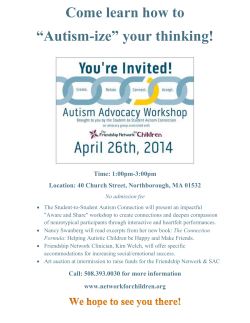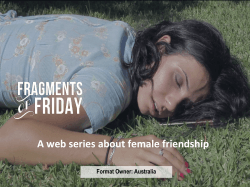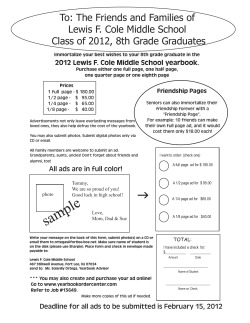
Friendship Groups 4th Grade Some kids make friends naturally, but
Friendship Groups 4th Grade Some kids make friends naturally, but for others, making and keeping friends is not so easy. Studies have shown that having even one friend significantly improves a child’s emotional health and school performance. Some children may struggle to make and keep friends because they do not intuitively know how to be a good friend. Teaching these children strategies may improve their social and friendship skills which may lead to higher emotional health and better school performance. The following 5 lessons will be performed over a 2 week period. Students will eat their lunch in the counselor’s office during their normal lunch break. The lessons may or may not be performed in order or followed exactly as written. If you have any questions or would like your child to join our “Lunch Bunch” or “Friendship group” please give me a call at 253.945.4230 Lesson 1 “Review of Rules” and “Introductions” Introduction: We go over rules, expectations and purpose of the group Introduce “Friendship Cards” I’ll go over 6 of 24 cards for the next 4 lessons -“Friendship cards” are 24 social skill prompts to help students make and keep friends Lesson: I’ll explain to them that I want them to learn how to be a better friend at school and they will be coming to my office for the next 2 weeks for lunch to learn some ways to be a better friend. Together we’ll participate in a get-to-know-you activity and then review what a good friend looks like and what good friends do. I will conclude the meeting with a “Just Checking in” work sheet to see how the students are currently doing with “School skills” Lesson 2 “Complement Circle” Introduction: After a quick review of the rules we’ll start activity 2. Review “Friendship Cards” go over 7-12 of 24 cards. Lesson: In this activity, group members must provide positive feedback for everyone in the group. I start by giving every student a piece of black paper and having them write their name at the top. Then, everyone passes their paper to the person on their left. The students write something positive about the person on their paper. When everyone is finished, we pass the papers again. This continues until the students have written on every paper but their own. Before the compliments are revealed. I have students discuss how they are feeling (Anticipation, worries, ETC,). Then, students read their compliments. We reflect as a group on the peer feedback and discuss how this could positively impact our friendships. If time permits, the students can choose from a variety of board games, puzzles, or toys to play with and practice their new learned skills with each other. I’ll closely monitor their interactions and give positive reinforcement and paraphrase positive behaviors. Lesson 3 “Different kinds of Friends We need them all” Objective: Students will learn the characteristics of friend types and be able to categorize their friendship. Introduction: Review of rules Review “Friendship Cards” go over 13-18 of 24 cards. Lesson: Tell the group you want them to think of the name of a friend. (Just think it, don’t say it out loud) The student’s will take turns using puppets talking about what best friends do with each other and what are some characteristics that best friends have. I’ll also have a puppet on to paraphrase things that the students have said, and to elaborate more about what a best friend looks like. I’ll define and review what different types of friends are. A “best friend” is someone you know very well with whom you can trust to share secrets and feelings. They like you a lot all of the time. A “Buddy” is someone you play with and share common interests with. An “acquaintance” is someone you don’t know very well or don’t see very often. If time permits, the students can choose from a variety of board games, puzzles, or toys to play with and practice their new learned skills with each other. I’ll closely monitor their interactions and give positive reinforcement and paraphrase positive behaviors. Lesson 4 Objective: Students will review and define what friendships are, and learn to associate positive words/phrases to the word friendship. Introduction: Review of rules Review “Friendship Cards” go over 19-24 of 24 cards. Lesson: Ask the group how they would define friendship and create a word bank of descriptive words and phrases. After we have our “friendship word bank” filled we will head to the computer lab and create a “Wordle” for them to print out, laminate and keep as a reminder of what a “Friendship” is. If time permits, the students can choose from a variety of board games, puzzles, or toys to play with and practice their new learned skills with each other. I’ll closely monitor their interactions and give positive reinforcement and paraphrase positive behaviors. Lesson 5 Objective: Students will review what we have learned and accomplished from “friendship groups” Introduction: Review of rules For our final lesson, we look back on our work and reflect on how far we have come. As a group we will define what friendships are and what makes a good friendship. As an extra reward I’ll have a prize box with items for the student to buy from with their “Participation Coupons”. Students will fill out an exit survey as their final “Friendship Group” session comes to an end.
© Copyright 2025









